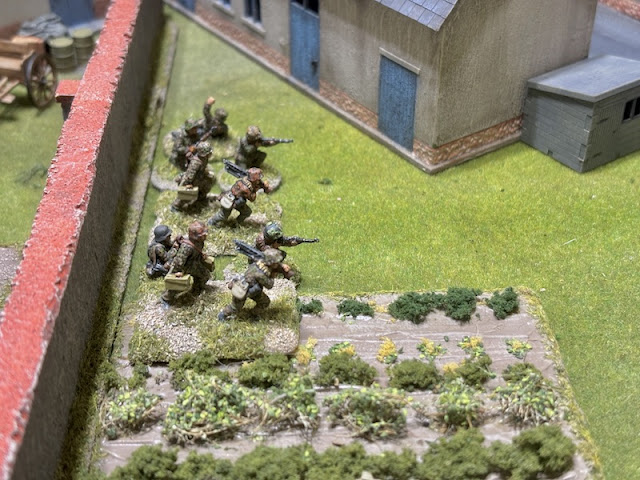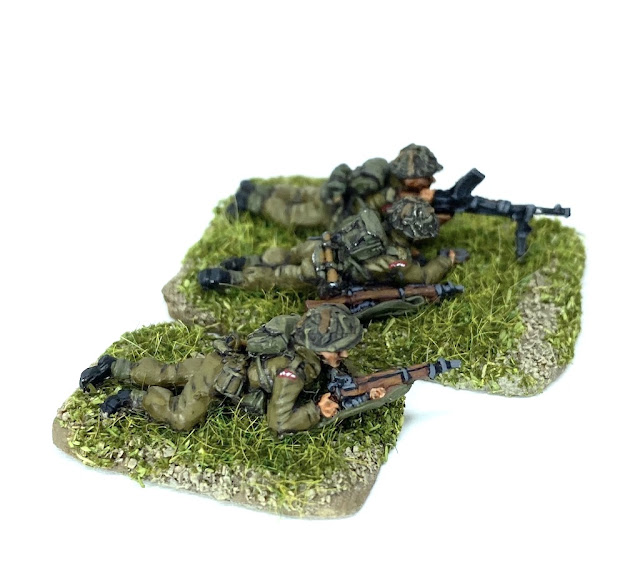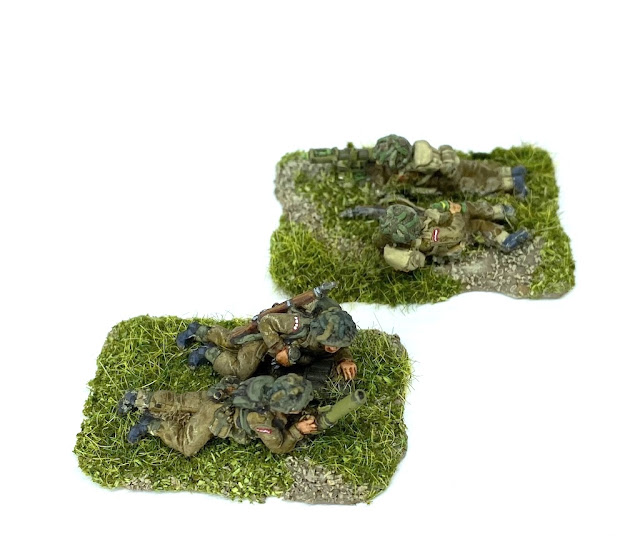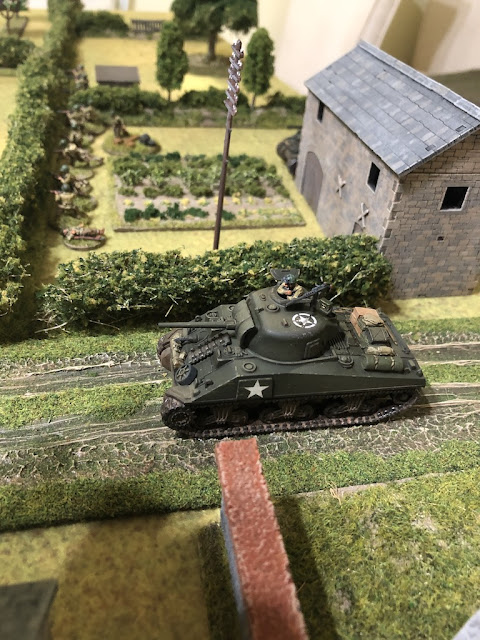There is no doubt that the German panzergrenadier platoon makes for a very tough opponent in Chain of Command and new players are often quick to suggest that they may be overpowered. While there is no denying they are powerful, it's important not to forget that this is how they were historically and the game reflects this. Their opponents were forced to find ways to try to counter them and, if we want our games to feel like we are playing the period and not the rules, then hopefully this tutorial can help you find a way to tackle these tough units.
If we make a comparison with a typical section from other nations, there is a clear difference in the amount of firepower that can be generated.
A typical British section is made up of a Bren team and a six man rifle team and can generate up to 14 fire dice (again, depending on range and how much the leader's sten gun can contribute). A Russian light section in the rifle platoon produces a similar amount of firepower. An American rifle platoon section is made up of a BAR team and an eight man rifle team and can also generate up to 14 fire dice, however their M1 Garand semi-automatic rifles give them a slight edge, benefiting from storm of steel.
A typical British section is made up of a Bren team and a six man rifle team and can generate up to 14 fire dice (again, depending on range and how much the leader's sten gun can contribute). A Russian light section in the rifle platoon produces a similar amount of firepower. An American rifle platoon section is made up of a BAR team and an eight man rifle team and can also generate up to 14 fire dice, however their M1 Garand semi-automatic rifles give them a slight edge, benefiting from storm of steel.
Whatever your allied option the panzer grenadiers come very well equipped to a fire fight. So, are they over-powered? Well, they are certainly strong and should prove a match for any opponent in a straight shoot out. In short, when most Allied sections take on a panzergrenadier section they can expect to come out worse off. So, what can you do when faced with these as opponents?
The main strength of the panzergrenadier section is undoubtedly the firepower from two belt fed LMGs. Their weakness is the platoon's solitary senior leader. That makes them less tactically flexible than most of their Allied counterparts. They can of course add a senior leader as support, but that is to draw on support points that their opponents may not need to consider. If the Allies can’t compete in a section-on-section firefight, where else can they look for an advantage?
One place to start is with the force rating. A panzergrenadier platoon is rated +2 (as much as +5 in the very rare case they are classed as elite). So this gives us force ratings differentials as follows:
- British platoon +2
- Russian platoon +2
Choosing these additional supports wisely will be one step to evening up the odds. It’s important you reduce the panzer grenadiers’ advantages and leverage their weaknesses. Additional firepower is a good start. Consider weapons that can produce good results beyond the 18” close range of the MG42. This could be HE in the form of an artillery piece, a mortar barrage or a tank, alternatively it could be additional fire support from a HMG. Weapons that reduce the level of cover and can operate effectively beyond ranges of 18” will mean you can apply pressure from a distance that diminishes the effect of any return fire.
Given the disparity in senior leaders, you want to look for supports that add to your tactical flexibility. For the British and Americans an Adjutant is a low cost support that allows you to have both senior leaders on the table. Not only does this provide more tactical flexibility, it allows you to rally off the inevitable shock that can accumulate once your units are under fire. With two senior leaders it is possible to consider an extra section as support. This is not so much for their additional firepower as the advantage of having one more manoeuvre element. This will give you movement options that the panzergrenadier platoon, with its single senior leader, may find hard to counter.
Panzergrenadier platoons that are able to deploy all their sections, and then concentrate their fire, are formidable. One of your aims is to prevent that happening, so that you can concentrate and try to overwhelm isolated panzergrenadier sections. Easier said than done, but if you are attacking, there are supports like a pre-game barrage that can help disrupt the speed at which the grenadiers deploy. Remember, you will be looking for those little chances that might give you an edge, when they occur, you have to capitalise. No point having a pregame barrage if you don't take the opportunity it presents when German units deploy unsupported.
Conversely, you will want to respond quickly once you have the opportunity. If you have two senior leaders, then getting both on the table for maximum effect should be something to aim for. This makes an Adjutant for one support point such an attractive choice. Particularly if you think bringing in an additional section is the best way to overwhelm the grenadiers. Two senior leaders on the table controlling four sections plus supports could give you the margin you need.
Your support choices will be determined partly by the layout of the table and the particular scenario, but time spent considering what will equip you best will be time well spent.
Give careful consideration to the layout of the terrain and develop a plan. No matter what you decide to do, you don’t want to expose your men to a lot of MG42 fire while you try to manoeuvre to your objectives, or to defend them. This means giving the patrol phase some thought. What are your best avenues for approach? Where do you expect to see the grenadiers and can you deny some of that terrain to them? Ideally you don’t want them able to deploy from several jump off points so that you face the combined fire of a number of squads. Look for ways you can build up the advantage at a key point and try to deny that to the enemy.
When the game starts don’t rush to deploy until you think it gives you an advantage. Try to create a situation where the Germans deploy first, then, once you have an idea of where they are, you can respond and avoid gifting them targets. You can use your support choices to create advantageous circumstances for deployment. For example, place a gun on Overwatch or have units lay down suppressing fire on potential German deployment terrain. The CoC v2 suppressing fire mechanic is an excellent way of disrupting your enemy's deployment. If the panzergrenadiers have elected to place jump-off-points in advanced positions you can try to disrupt their deployment to concentrate on the units that have deployed.
I can’t stress enough how important it is to delay deploying your units until it suits your plan. If you offer the panzergrenadiers targets you can be sure they will exploit the opportunity. You will start losing casualties and building up shock, for no discernible gain. New players have a tendency to rush their deployment, anxious that somehow they will be caught out if they don’t. Ask yourself the question, why am I deploying? It should be only because you can see it gives you an advantage. As the defender you will often find that staying hidden works much to your advantage - without targets to shoot at the commander of the panzergrenadiers might be lured into weakening their position seeking out your units.
At some point it’s inevitable that you will engage in a firefight, so make sure you have tactics in mind to reduce the odds in the German favour.
You want to return fire, but you also want to reduce the effect of their fire. You can do this by having some of your units lay down suppressing fire, this reduces their chances of hitting by 33% at close range and by 50% at effective range. Your other units can then fire normally. Expect to take shock, however this is where your additional senior leader will come in useful. In addition to providing you more tactical options, together with the junior leaders, they can help keep shock at manageable levels.
The British have several advantages when it comes to dealing the panzergrenadiers. Their national characteristic of Concentrated Fire allows you to direct the fire of a bren team at a single MG42 team, which greatly increases the chance of wiping out one of those teams. It is surprising how brittle a panzer grenadier section becomes once it has lost one of its teams.
The British also have an excellent platoon asset in the 2” mortar. While the HE rounds can cause damage, it’s the smoke rounds you will find most useful.
You then activate the senior leader and use two Orders to have the Bren team use Concentrated Fire and target one of the MG42 teams (if they have already taken casualties, then it would make sense to target the one with the least men). That way you will have put at least six fire dice on one MG42 team plus whatever hits are shared between both teams from the fire dice from the rifle team, that's a potentially up to twelve hits on a four man team. Keep in mind that there could be additional hits as the Bren team benefit from storm of steel when ordered to use Concentrated Fire.
Finally, the senior leader uses his last Order to have the 2” mortar fire a round of smoke to blind the larger of the MG42 teams, the one that wasn’t hit with Concentrated Fire.
Based on average dice, you would expect the smaller MG42 team to take five hits and assuming they are in light cover this would result in something like one dead and two shock. The casualty will reduce the team to three men. When you factor in the two points of shock you have reduced the firepower from this team from eight to seven. More effectively the smoke from the mortar has blocked off the fire from the other MG42 team. That way you have reduced the return fire from that panzergrenadier section from eighteen fire dice to seven.
If you are able to put suppressing fire down on the MG42 team that still has a line of sight, you would then reduce the chance of that team hitting any targets by 33%. In other words, assuming average dice we would expect 2-3 hits on the British in return.
This combination is peculiar to the British, but there are other ways to tackle the situation. The Americans are able to move and fire using Marching Fire. With the MG42 teams restricted to a fixed arc of fire if they are on overwatch or choose to react fire, it should be possible for the Americans to use the superior command and control of a second senior leader to try to dislodge the panzergrenadiers by manoeuvre and threatening their flanks - all while using their semi-automatic M1 Garands to benefit from storm of steel while firing on the move.
The biggest danger from the grenadiers is the concentration of fire across several sections. This is where a mortar barrage is very useful.
The panzergrenadiers cannot afford to concentrate too close together for fear of having too many units trapped under the barrage. All well and good for you if they do. If they don’t, it probably means they may not be mutually supporting, which will allow you to try to gang up on individual sections and outnumber them.
The ability of heavy weapons like HMGs or tank guns to reduce the level of cover and/or hit on a 4, 5 or 6 from any range, should mean you have called on support choices that can blast panzergrenadier sections out of their positions. They take hits and shock just like any other troops and not many sections will stay in a building for long once they are on the receiving end of a few HE rounds. Keep in mind that you are probably facing these Germans in 1944 or ’45, in which case you do need to be very wary of infantry anti-tank weapons. This is one reason you want to make full use of the long range of tank guns to sit back and fire from a distance. There is no advantage to closing the range for tanks, you only offer yourself up for a panzerfaust round if you do.
The key thing to keep in mind is that you are very unlikely to beat the panzergrenadier platoon by seeking a firefight. While you can’t avoid engaging them entirely, your aim should be to find a way to beat them in detail, preferably taking on single sections where you can build up an advantage. This requires you to capitalise on any passing window of opportunity. If there is a fleeting chance to overwhelm a single section you need to react quickly and aggressively. Exploit your numerical superiority in leaders and any support advantage, then pile it on.
Ultimately though, I believe your aim should be to manoeuvre them out of position. If they are moving, they are not shooting. Again, this is where your leaders and tactical flexibility should be exploited to work around flanks, approach blind spots and outnumber individual sections. This also applies if you are defending. Simply opposing them in a firefight will most likely have your units shot from their positions. You need to consider ways to draw the grenadiers into killing grounds or areas you can work around flanks.
CoC points are your friend here. If the fire is getting too hot, then use a CoC die to interrupt and move out of harm's way, or three CoC points to hit the dirt. You could interrupt to fire first, but only choose that option if you have a clear advantage, for example, if the panzergrenadiers have lost a few men and acquired shock. If they are in hard cover, you run the risk of doing little damage before receiving their fire, better to slip away. Alternatively, use CoC points to reposition to move to better cover.
CoC points are your friend here. If the fire is getting too hot, then use a CoC die to interrupt and move out of harm's way, or three CoC points to hit the dirt. You could interrupt to fire first, but only choose that option if you have a clear advantage, for example, if the panzergrenadiers have lost a few men and acquired shock. If they are in hard cover, you run the risk of doing little damage before receiving their fire, better to slip away. Alternatively, use CoC points to reposition to move to better cover.
The panzergrenadiers are tough opponents and there is no magic formula. Any success is likely to be the result of carefully coordinating all the factors at play in the game. Sometimes it will just need a bit of luck.
- Think through all the elements of the scenario, from the map to the victory objective, and formulate a clear plan.
- Ensure you call on the right supports that will best enable you to execute that plan.
- Determine where you want your jump off points to be and where you want to prevent your opponent's to be placed.
- Consider your deployment very carefully and only bring on units where you can see an obvious advantage. Don’t gift your opponent targets without a clear gain.
- Use tactics that limit the grenadiers firepower advantage - use suppressing fire, blind them with smoke, target single units, use HE from beyond close range, call in a barrage.
- Exploit your advantage with senior leaders to keep on top of shock and use manoeuvre to keep the panzergrenadiers off balance and threatened.
I had some experience fighting panzer grenadiers playing the Kampfgruppe Von Luck pint sized campaign. In one scenario I tried to put several of my thoughts on how to deal with them into practice and you can follow my thinking and what unfolded in the scenario The Church on the Flank. Keep in mind this was played a few years ago using the v1 rules, but not enough has changed in v2 to make what happened redundant.
While I won the campaign, I lost this particular scenario, but not without inflicting considerable damage on one of the panzergrenadier platoons, so I hope this will give you an opportunity to see how I tried to apply some of the ideas set out in this article.











What a splendid post, nice to see a lets deal with it rather than a whinge about it attitude.
ReplyDeleteThanks Phil, that was what partly inspired me to write it, too many people implying the game was broken, when often it was the tactics that were at fault.
DeleteUseful advice thanks!
ReplyDeleteAll good advice- thanks
ReplyDeleteReally enjoyed that, good read thanks
ReplyDeletePretty good overview on the tactics available in a CoC game. Good to see thoughts written down.
ReplyDeleteAh, so that's where I've been going wrong. Sound advice there. I'll need to make a note of them for my next game. thanks
ReplyDeleteI hope you find it useful - no guarantees it will work, those PG are tough and don't go down easily.
DeleteLots of good ideas.
ReplyDeleteWell thought out post and well written. In my CoC games (man it’s been awhile) we found PG too tough and just started using regular grenadiers. Especially when PG on defense. Bit of a cop out I know...😀
ReplyDeleteThank you Mark for this article, very helpful.
ReplyDeletecheers John
Hi Mark/ everyone - a very important point to note. A PnzGren. Platoon actually puts out 21D6 in total, not 19D6, as the ammo bearer for the MG teams (the third crew) can also use his rifle. This has been confirmed by the great man, Richard Clarke, of TooFatLardies, who actually wrote the rules. See his blog comment at the bottom of the conversation thread here: https://toofatlardies.co.uk/forum/viewtopic.php?t=458.
ReplyDeleteSo the first MG team generates 11D6 and the second MG team generates 10D6 = 21D6, excluding the Junior Leader's SMG.
I think you may have misunderstood what Rich is saying. In the PZGrenadnier squads you have two LMG teams. The men listed as crew, are just that, they have a full time role crewing the LMG and may not fire their rifles. The others listed as riflemen are also 'crew' however they are also free to use their rifles, hence the distinction in the force list in the LMG teams between 'crew' and 'rifleman'. So in the Von Luck campaign one LMG team has four men and the other has five. Each LMG requires a dedicated three man crew, the additional riflemen are ammo carriers but may also fire their weapon.
DeleteI'm absolutely OK with this because: (a) it's historically accurate and (b) I play a standard British Platoon so use BOTH National Characteristics to defeat the PnzGrens. :)
ReplyDeleteI also use cover, going 'tactical', smoke (from 2" mortars & smoke grenades), covering fire, Overwatch, firing first, etc., to negate their firepower advantage.
In addition, do NOT under-estimate the use of a Pre-Game Barrage and off-mortar barrages to make life even more difficult for the PnzGrens - they ARE beatable if you have a plan and you use all of the game's varied options to defeat them !! :)
P.S.: I also use an Adjutant (for only ONE Support Point !) so that I can have TWO Senior Leaders on the battlefield using their 3 Command Initiative Points to activate National Characteristics (in attack) and to rally off Shock quickly (in defence).
Hope this helps ?
Best Wishes, John (who also wrote the post just above !).
Any advice for players using Russian forces? We have less commanders, no smoke and no foo!
ReplyDeleteI am currently having a hard time playing a German PG Platon in the Martlet Campaign. Your thoughts are most welcome!
ReplyDeleteHi! I'm looking through the FAQ and I can't find where they changed the force rating from a +1 to a +3, is there another FAQ put there I don't have or was this a mistake? Thanks!
ReplyDeleteMake sure you have the v2 FAQ, which is available from the Lardy Blog website. You will find it on the fourth page in the section 'Appendix B' where it lists chance in some ratings.
DeleteI'll take a look, thanks!
DeleteYep the FAQ I had was 9 pages, this one is almost 30 haha
DeleteGreat article. When you talk about one shortcoming of the German squads being their having just one junior leader I'm guessing you are referring to the extra leader available at the platoon HQ level for the US and GB as I can't see any squads that have an integral second leader. New to COC though so I might be reading it wrong. While the second leader is a bonus for sure it's an extra one split between 2-3 sections, not one per section. So yes it's a disadvantage but not perhaps THAT much?
ReplyDeleteVery interesting article
ReplyDeleteOne of the downsides to Panzergrenadiers is that their support list is so limited.
ReplyDeleteDon't get me wrong, they still have some frightening and effective choices (I've read a couple of the AARs!) but you have a better idea of what they'll be bringing, fewer surprises, and certain of your options will be more effective (no Engineers on their part means your barbed wire etc is more effective, and so on)
Sorry, I'm speaking specifically of the Kampfgruppe von Luck platoon - it's my understanding that the PzG in the main book have access to the same support choices as any other German platoon in that book.
Delete